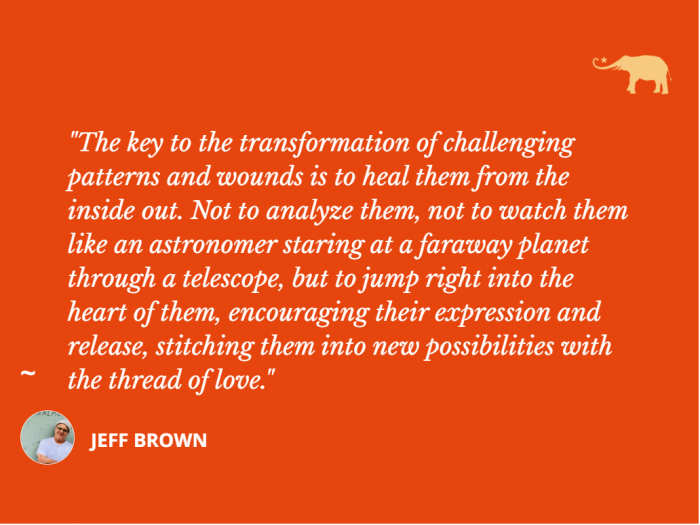After a traumatic and disempowering childhood, much of my life’s work has been about building a healthy and empowered sense of self.
Not a narcissistic sense of self, but one that is rooted in a healthy ego and a recognition of the great possibilities that live within each of us.
I believe that every one of us comes into this life with a brilliant and unique sacred purpose, a network of gifts, callings, lessons, significant relationships, and key emotional issues that we are here to clarify—to express, to actualize, and to grow through.
Our sacred purpose is our unique contribution to the world.
In order to fully embrace our purpose and make self-affirming life choices, we need an authentic sense of our own value. We need to believe that we are worthy of bringing our gifts and offerings to the world. Because so few of us were given a healthy template for self-validation, we often have to forge that template ourselves, in the fires of our own determination.
Here are three tools that helped me reach the stage of self-validation where I could see my purpose through in a challenging world:
1. Practice the art of selective attachment.
Given that our sense of self was wounded in relationship, some part of it has to be restored through relationship. We are relational beings, after all. But relational healing can’t happen with just anyone. We have to cultivate the art of selective attachment.
In other words, we have to sift everything through a self-validation filter, connecting only to those relationships that support our healthy self-development. If someone bolsters our sense of value, we invite them in. If they don’t, we turn them away. In other words, self-validators enter, light-dimmers exit. Not from a place of contempt, but from a place of burgeoning self-love.
We already have enough internalized voices telling us that we don’t have value. We don’t need any more. If they don’t help you grow, then let them go. Who you surround yourself with really matters.
Of course, we can get all the validation we want, even if it comes from someone credible, but it won’t be enough. We still have to take proactive steps to confirm our value.
2. Affirm your value.
Affirmations can be a positive step in the direction of self-empowerment. It can be encouraging to repeat self-validating affirmations throughout the day. For example, “I am enough,” “I am worthy of a healthy relationship,” “I am worthy of self-love,” “I am brilliant.” These mantras can keep you going, particularly during challenging moments, and can bolster your sense of self.
On their own, they are not enough to deeply transform you. In order to build a strong and sturdy sense of self, your words need to be coupled with self-affirming actions. In other words, you need to prove to yourself that you matter. You have to make your affirmations real. There has to be a congruency between what you are expressing and what you are living before your inner world will take notice.
By making your affirmations real, you send a message to the deep within that you are worthy enough to wage this battle for self-love. If we don’t prove to ourselves that we are willing to fight for our right to the light and our right to a healthy self-concept, who will?
This work may require that we go to the edge of our discomfort and make empowering new choices. For example, if you are someone who has had a hard time speaking up for yourself, shift the pattern by clearly and confidently voicing your needs or desires. Or if you are someone who has resisted exploring a more gratifying career path, take one step in the direction of a new career.
Even the smallest and shakiest of steps can transform your inner landscape.
To make your affirmations real, finish the things you start. Prove to yourself that you can see things through to completion. This can include important and meaningful life goals, or practical and menial everyday tasks. It doesn’t matter if they are lofty accomplishments or simple actions. What matters is that you drown your negative self-talk in a sea of accomplishment.
3. Heal your core wounds.
Fundamental to our efforts to self-validate is the importance of going back into the past to heal our core wounds. At the heart of a diminished self-concept is invariably some combination of unresolved abuse, trauma, and unmet needs. And it’s seldom ours alone, most of these dysfunctional patterns have roots in our family lineage and ancestral patterns.
In other words, we are carrying everyone’s emotional material up the rocky mountain with us.
The way we break free from dysfunctional familial patterns is not by running away from them. It’s by walking back in their direction. Not because we want to keep repeating them, but because the only way to shift these patterns is to heal them at their roots. It’s okay to run from them for a time, but not for all time, because the flight from what lives inside of you merely delays your arrival.
You may think you are on the way to a new destination, yet the plane keeps circling back to your childhood home. It can’t navigate a new flight plan until you return back to where you came from and heal your broken wings. With your wings strengthened, there is nowhere you can’t go.
The healing can happen in many forms. Talk therapy can be an effective tool in seeing and understanding the roots of our diminished sense of self. With the right therapist, you can talk through and reclaim those parts of you that got lost along the way. You can come to terms with where the voices of self-hatred and internalized shame originated.
But identifying and analyzing our wounds is not always the same as healing them. Excessive analysis can perpetuate emotional paralysis, strengthening your mental capacities while possibly delaying your deeper healing. An effective recipe for healing is to couple your talk therapy with a body-centered psychotherapeutic approach.
Body-centered models like somatic experiencing, bioenergetics, and core energetics engage both your mental faculties and your capacity for deep feeling, supporting a more integrated healing. Your negative self-talk may be manifest as thinking, but its roots are often in the traumas endured within the emotional and physical bodies.
Our traumas were a felt experience, and if we want to transform them, we have to meet them directly, within the body itself. The feel is for real.
The key to the transformation of challenging patterns and wounds is to heal them from the inside out. Not to analyze them, not to watch them like an astronomer staring at a faraway planet through a telescope, but to jump right into the heart of them, encouraging their expression and release, stitching them into new possibilities with the thread of love.
You want to live a self-empowered life? Heal your heart. That’s the best affirmation of all.
Continuing the Work
Building a healthy self-concept takes more than recognizing why we don’t have one. We have to do the work to construct a new egoic foundation. That work is not merely conceptual; it is rooted in embodied, lived experience: supportive relationships, positive affirmations coupled with meaningful action, addressing our emotional wounds, and eventually healing our way home.
If you can stay with these tools for long enough, the voices of internalized shame and self-hatred will grow quieter, and a voice of self-love will rise up to occupy space inside of you. Your inner narrative will shift from a tone of shame, to a tone of self-value. You will no longer make choices sourced in an over-compensatory quest for external validation, you will make choices that are rooted in self-love.
Self-regard will become your natural and organic way of being, and you will become emblazoned on your path, living your life like the force of purposeful nature that you are.
We are all beautiful and brilliant beings at heart. The trick is clearing the obstacles and doing the rewarding work to build a foundation of enduring self-regard.
When we do, we stop getting in our own way, and we live the life we were born for.













Read 9 comments and reply